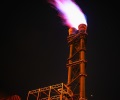
[ad_1]

Analysts expect another below-average natural gas injection to US storage fields for the week ended June 18 as multiple regions near the halfway point of the season with sizable deficits to historical norms.
The US Energy Information Administration is expected to report a 63 Bcf injection for the week ended June 18, according to a survey of analysts by S&P Global Platts. Responses to the survey were narrow, ranging from a 59 to 71-Bcf injection. The EIA plans to release its weekly storage report on June 24 at 10:30 am.
A 63 Bcf injection would be less than the five-year average build of 83 Bcf during the corresponding week. It would expand stocks to 2.490 trillion cubic feet Tcf. US storage would measure 146 Bcf below the five-year average, and the deficit to 2020 would expand to 505 Bcf.
The injection would be nearly half the 115 Bcf injection that was reported for the same week in 2020. This highlights how much tighter the market has become between then and now, as production continues to underwhelm while export demand and power burn show no signs of slowing down, even despite a stronger balance-of-summer price strip that has almost doubled from a year ago.
The NYMEX Henry Hub July contract added 7 cents to $3.26/MMBtu during trading on June 22. The balance-of-summer, July through October, added 5.5 cents to $3.26, which was only about 12 cents below the upcoming November through March winter strip.
The week ended June 18 saw a massive reshuffling of supply and demand among the various EIA regions, driven by a surge in power generation demand in the South Central and Western regions alongside a large drop in demand in the East.
Virtually all of the supply length was centered on the East and Midwest regions alone, while the South Central, Mountain, and Pacific regions each were left with single-digit cumulative storage builds, indicating tight, albeit nearly balanced, markets in those areas, according to EIA data.
The East region saw the largest increase week over week in volumes injected into storage, as S&P Global Platts Analytics estimates inventories increased by 25 Bcf during the week, or 9 Bcf more than the week before. This was offset, however, by similar declines in both the South Central and Pacific regions, where inventories are expected to have risen by 9 Bcf less each compared with the preceding week.
Despite sputtering LNG feedgas demand along the Gulf Coast thought to be linked to scheduled but unannounced liquefaction maintenances, markets remained notably tight in the South Central as temperatures there surged, driving up power demand.
Platts Analytics’ supply and demand model expects a 67 Bcf injection, for the week ending June 27, which would measure in line with the five-year average build of 65 Bcf.
Source: Platts
[ad_2]
This article has been posted as is from Source